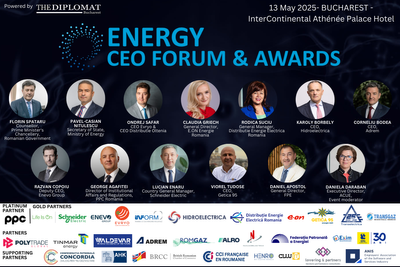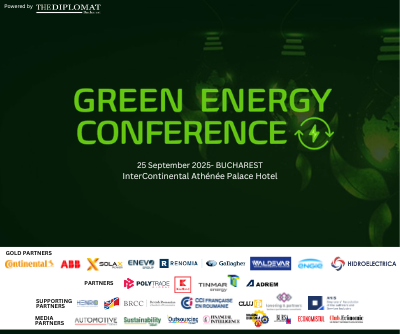Automotive industry – between the component crisis and environmental goals

Opinion by Ciprian Gavriliu, Fiscal Services Partner, Deloitte Romania
The automotive industry has recovered faster than initially forecast after the blockage caused by the COVID-19 pandemic in 2020 worldwide. At European level, sales are up on last year and demand remains high. However, carmakers face several challenges for the period ahead – the crisis of components and raw materials, the uncertainties generated by the pandemic, the investment needed for electrification and digitization, in the context of the environmental objectives announced by the authorities, and the tax implications of these transformations.
Companies active in the automotive market, especially manufacturers and suppliers of components, have been affected in the last two years by restrictions imposed in the context of the pandemic, including from the perspective of labour, the semiconductor crisis, but also by the pressures exerted by structural changes just before the pandemic – the orientation towards electric motors, autonomous driving, connected cars and shared mobility.
Against the background of estimates of the diminishing effects of the global pandemic and the return of the microchip market, manufactured in Asian countries, on which all car manufacturers are dependent, industry players are preparing their market strategy for the next decade.
We are in the midst of a global revolution that has two global drivers and goals behind it, namely environmental protection, and the accelerated evolution of technology. The automotive industry is a significant player in this revolution, and innovation plays a key role in the transformation process. The car will become much more than a means of transport, it will become a device connected, via the Internet, with the manufacturers, with the driver and passengers, with other technologies. And at the same time, it will have to become “green” or non-polluting by drastically reducing CO2 emissions. We could say that in the future, we or our children will drive a robot, not a means of transportation. A robot that will generate a huge amount of data about the driver’s behaviour, the condition of the car, the condition of the road, the real-time dangers on the road, the level of pollution and many more aspects related to mobility.
In this context, electrified vehicle (EV) component groups are experiencing sustained increases globally, while internal combustion engine (ICE) components are either stagnant or declining, according to global Deloitte analysis. And the wave of new technologies currently available or looming on the horizon should lead both manufacturers and component suppliers to focus on properly preparing for what is to come, analysing strategic partnerships and alliances to ensure future growth.
The European market is growing especially in the segment of electric cars
In Europe, the car market grew in the first nine months of 2021, both in the passenger segment (+ 6.6%) and in the commercial vehicle segment (+ 19.1%), but the evolution is largely due to the effect basic (poor results in 2020), according to data published by the Association of European Car Manufacturers. Romania followed the same trend, with an advance of sales on the passenger segment of 4.3%, in the mentioned period, and of almost 30% regarding the commercial vehicles.
At the same time, buyers’ preference for fewer polluting cars is becoming increasingly evident. Registrations of hybrid electric passenger cars accounted for more than 20% of the total EU market in the third quarter of 2021, surpassing the diesel segment and becoming, for the first time, the second most popular motoring option in the union. During the same period, the demand for electric battery vehicles (BEV) increased by 56.7% (compared to the third quarter of 2020), due to incentives in different markets. As a result, all four major EU markets saw double or even triple-digit growth: Italy (+ 122%), Germany (+ 62.7%), France (+ 34.6%) and Spain (+21, 8%), according to data from the European Association.
Plug-in hybrid electric vehicles (PHEVs) also expanded their share of EU car sales, with registrations up 42.6%. Italy also recorded the strongest rise among the four key markets, with 130.6% in the third quarter of 2021, followed by Spain (+ 87.5%), France (+ 49.5%) and Germany (+37 ,5%).
The demand for hybrid electric vehicles (HEV) has also increased significantly in the last three months (+ 31.5%) and, with half a million units sold, they remain in first place in the top of alternative engines in terms of volume.
Ambitious environmental goals, costs to match
Therefore, the market is already moving in the direction set by the EU through the announced environmental objectives – Europe to become the first climate-neutral continent by 2050, according to the European Green Pact (Green Deal); reducing emissions by at least 55% by 2030, an intermediate target set by the Fit For 55 initiative.
But to achieve these goals, the European Commission is proposing ambitious targets in the field of transport, namely reducing CO2 emissions from cars by 55% and trucks by 50% by 2030, and zero emissions for new cars by 2035. .
To this end, the institution promotes the development of the market for low or zero emission vehicles and aims to ensure that citizens have the necessary infrastructure to load these vehicles, both for short and long journeys. On the other hand, the authorities are announcing measures to deter polluting engines. The EU Council has already given the green light to the reform of road taxation (Euro vignette), so that heavy vehicles, initially the largest trucks, can be taxed according to CO2 emissions, and the system will be gradually extended to other types of heavy vehicles. . The European directive on this subject is being drafted and Member States will have two years from entry into force to include the provisions in their national legislation. The system is scheduled to enter into force in 2026 and is at the same time a price for pollution and an incentive for the use of less polluted fuels and for investments in green technologies.
Investments in electric models require government support
Automakers have already announced cumulative investments of $ 515 billion over the next five to ten years to electrify their ranges. According to a Reuters analysis, almost all companies have launched or will launch electric cars, from Dacia to Rolls Royce, given that many countries will no longer allow the sale of new cars on gasoline or diesel after 2030. But company representatives remain concerned that the demand for electric cars could be lower than their targets, without supplementing government subsidies for such purchases and without sufficient investment in charging infrastructure.
Therefore, players in the field must closely monitor the changes that are taking place during this period and in the years to come, both in the car industry and in the global economy as a whole and take into account the environmental objectives of the authorities, which are quite costly. to which they must contribute, both by investing in clean technologies and by paying possible taxes during the transition period.
In conclusion, it seems that there has never been a more interesting, technologically advanced period in the automotive industry, but most likely, time will soon become the most problematic resource for players in the industry, given the persistence of malfunctions. in the supply chains and the speed with which new technologies must be implemented in order to remain relevant in the market.



















